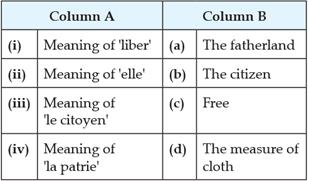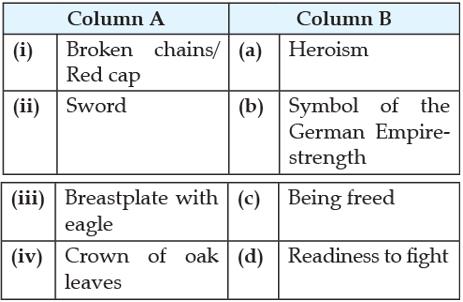
The Age of revolutions
Quiz
•
History
•
10th Grade
•
Hard
Goutham Krishna
Used 11+ times
FREE Resource
20 questions
Show all answers
1.
MULTIPLE CHOICE QUESTION
10 sec • 1 pt
The meaning of Volksgeist:
Common People
Spirit of the nation
Music
None of the above
2.
MULTIPLE CHOICE QUESTION
20 sec • 1 pt
Assertion: Culture played an important role in creating the idea of a Nation.
Reasons: Weavers in Silesia had led a revolt against contractors who supplied raw materials and gave them orders for finished textiles but drastically reduces their payments.
Both Assertion and Reason are true and Reason is the correct explanation of the Assertion
Both Assertion and Reason are true but Reason is not the correct explanation of the Assertion
The assertion is true but the reason is false
The assertion is false but the reason is true
3.
MULTIPLE CHOICE QUESTION
20 sec • 1 pt
Assertion: Giuseppe Mazzini worked with the conservatives for the monarchy.
Reason: Italy had to continue to be a patchwork of small states and kingdoms.
Both assertion and reason are true and the reason is the correct explanation of assertion.
Both assertion and reason are true but the reason is not the correct explanation of assertion. B. C.I D.
The assertion is true but the reason is false.
Both assertion and reason are false.
4.
MULTIPLE CHOICE QUESTION
20 sec • 1 pt
Assertion: From the very beginning, the French revolutionaries introduced various measures and practices like the idea of la patrie and le citoyen.
Reason: This was done to create a sense of collective identity amongst the French people.
Both assertion and reason are true and reason is the correct explanation of assertion.
Both assertion and reason are true and reason is the correct explanation of assertion.
Assertion is true but reason is false.
Both assertion and reason are false.
5.
MULTIPLE CHOICE QUESTION
20 sec • 1 pt
Assertion: On 18 May 1848, 831 elected representatives revolted in the Frankfurt parliament.
Reason: The elected representatives revolted against the issue of extending political rights to women.
Both assertion and reason are true and the reason is the correct explanation of assertion.
Both assertion and reason are true but reason is not the correct explanation of assertion.
Assertion is true but reason is false.
Both assertion and reason are false.
6.
MULTIPLE CHOICE QUESTION
20 sec • 1 pt
Assertion (A) : The French Revolution was an influential event that marked the age of revolutions in Europe.
Reason (R) : The French Revolution transferred the sovereignty from the people to the monarch.
Both (A) and (R) are true and (R) is the correct explanation of (A).
Both (A) and (R) are true but (R) is not the correct explanation of (A).
(A) is correct but (R) is wrong.
(A) is wrong but (R) is correct.
7.
MULTIPLE CHOICE QUESTION
20 sec • 1 pt
Assertion (A) : A large part of the Balkans was under the control of the Ottoman Empire.
Reason (R) : The spread of the ideas of Romantic Nationalism in the Balkans together with the disintegration of the Ottoman Empire made this region very explosive.
Both (A) and (R) are true and (R) is the correct explanation of (A).
Both (A) and (R) are true but (R) is not the correct explanation of (A).
(A) is correct but (R) is wrong.
(A) is wrong but (R) is correct.
Create a free account and access millions of resources
Create resources
Host any resource
Get auto-graded reports

Continue with Google

Continue with Email

Continue with Classlink

Continue with Clever
or continue with

Microsoft
%20(1).png)
Apple
Others
By signing up, you agree to our Terms of Service & Privacy Policy
Already have an account?
Similar Resources on Wayground

20 questions
US Citizenship Test
Quiz
•
10th - 11th Grade

17 questions
1st 9 Weeks Review 2024
Quiz
•
10th Grade

20 questions
Rządzący i rządzeni w średniowieczu
Quiz
•
10th - 12th Grade

20 questions
SKOR KERTAS 1 TINGKATAN 5
Quiz
•
10th Grade

20 questions
State Capitals
Quiz
•
6th - 12th Grade

15 questions
Philippine National Heroes 2
Quiz
•
4th Grade - Professio...

20 questions
Gandhi Jayanti
Quiz
•
3rd Grade - Professio...

19 questions
Unit 5: The Great Depression & the New Deal - modified
Quiz
•
9th - 12th Grade
Popular Resources on Wayground

20 questions
Brand Labels
Quiz
•
5th - 12th Grade

11 questions
NEASC Extended Advisory
Lesson
•
9th - 12th Grade

10 questions
Ice Breaker Trivia: Food from Around the World
Quiz
•
3rd - 12th Grade

10 questions
Boomer ⚡ Zoomer - Holiday Movies
Quiz
•
KG - University

25 questions
Multiplication Facts
Quiz
•
5th Grade

22 questions
Adding Integers
Quiz
•
6th Grade

10 questions
Multiplication and Division Unknowns
Quiz
•
3rd Grade

20 questions
Multiplying and Dividing Integers
Quiz
•
7th Grade
Discover more resources for History

16 questions
Government Unit 2
Quiz
•
7th - 11th Grade

10 questions
Exploring WW1 Through Oversimplified Perspectives
Interactive video
•
6th - 10th Grade

10 questions
Exploring Mendeleev's Periodic Table Innovations
Interactive video
•
6th - 10th Grade

10 questions
Exploring the Causes of the American Revolution
Interactive video
•
6th - 10th Grade

10 questions
Early River Valley Civilizations
Quiz
•
6th - 12th Grade

12 questions
CE 2b Early Documents Review
Quiz
•
7th Grade - University

20 questions
Unit 6 FA: Scientific Rev, Enlightenment, and Absolutism
Quiz
•
10th - 12th Grade

12 questions
World Civ Unit 2 Vocab
Quiz
•
9th - 12th Grade


